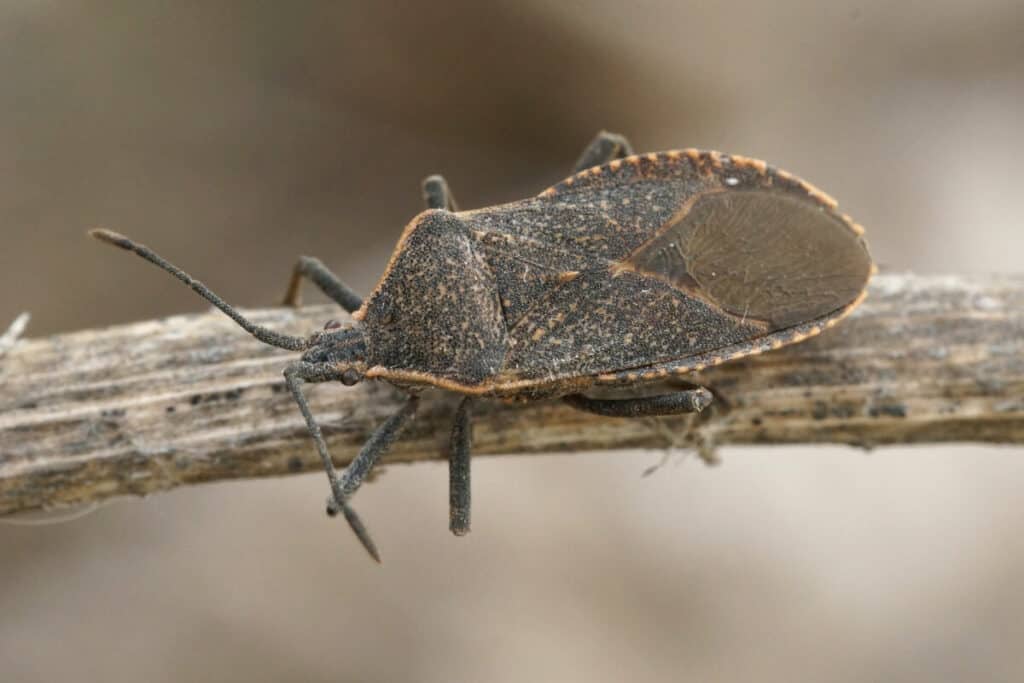Squash bugs can be a real pain for growing and maintaining vegetable plants. These irritating pests are not only annoying, but they can also cause serious damage to your precious plants.
In this blog post, we’ll examine how to identify squash bugs, what kind of damage they do, and some tips for controlling them in your veggie garden.
What are squash bugs?
Squash bugs are small, brownish-gray pests that measure about 1/2 inch long. They have six legs and a hard shell-like covering. They are most commonly found on squash or pumpkin plants, but they can also infest other vegetables such as cucumbers, melons, and zucchini.
Squash bugs feed on the leaves of the plants by piercing them with their sharp mouthparts and sucking out the sap. This can cause yellowing or wilting of the leaves and may even lead to plant death if left unchecked.
They typically lay the eggs in clusters on the underside of leaves near stem joints and hatch into nymphs within a few days. These nymphs go through several stages before reaching adulthood in roughly three weeks.
What damage do squash bugs cause on plants?
Squash bugs feed on the leaves by piercing them with their sharp mouthparts and sucking out the sap, which can lead to yellowing or wilting of the leaves. These pests can also transmit plant diseases, leading to further damage and crop loss.
They typically lay the eggs in clusters on the underside of leaves near stem joints and hatch into nymphs within a few days. As they feed, these nymphs become larger and more numerous, causing even more extensive damage to your plants. Sometimes, squash bug infestations can cause complete crop failure if not treated promptly.
How to identify squash bugs on plants

To identify squash bugs on your plants, look for the adults, which are small, brownish-gray pests that measure about 1/2 inch long. They have six legs and a hard shell-like covering.
You can also spot their eggs, which are typically laid in clusters on the underside of leaves near stem joints. Look for the signs of damage caused by these pests, such as yellowing or wilting of the leaves and plant death if left unchecked.
Read more:
How to get rid of squash bugs
Handpick: Inspect plants regularly and remove adult squash bugs and egg masses by hand.
Insecticidal soap: Spray the leaves of affected plants with an organic insecticidal soap to kill the pests. Be sure to cover both sides of the leaves and apply two or three times over a week to ensure all the bugs are killed.
Neem oil: Spray neem oil on affected plants to repel squash bugs and prevent them from laying eggs on your crops.
Diatomaceous earth: It works by cutting into the exoskeleton of pests, resulting in dehydration and death. To apply Diatomaceous Earth to your plants, put on a dust mask and lightly sprinkle it around all sides of the plant and in the soil near it.
Read more:
- How To Stop Insects Eating Plant Leaves
- Insecticidal Soap vs Dish Soap for Pest Control
- How to Use Neem Oil and Save Your Plants
- How To Use Diatomaceous Earth In Potted Plants
How to prevent squash bugs on plants
Plant resistant varieties: Some squash varieties are more resistant to squash bugs, so plant these when possible.
Keep the area clean: Remove weeds and debris near your plants since that’s where squash bugs hide during the day.
Use row covers: Cover your vegetable garden with a floating row cover to prevent adult squash bugs from reaching your plants.
Interplant with strong smelling herbs: Grow garlic, onions, or mint near your vegetables as these have been known to repel some insects such as squash bugs.
Host vegetable plants for squash bugs
Squash bugs are most commonly found on squash or pumpkin plants, but they can also infest other vegetables such as cucumbers, melons, and zucchini. These plants contain compounds that attract squash bugs to lay their eggs and give them a place to hide during the day.
Natural predators of squash bugs
There are several natural predators of squash bugs that can help to reduce their populations. These include ground beetles, tachinid flies, and parasitic wasps.
Ground beetles eat both the eggs and the adult pests. Parasitic wasps lay their eggs in the bodies of squash bugs, which then feed on them as they develop into larvae. Tachinid fly larvae feed on the nymphs of squash bugs.
References
- https://extension.umn.edu/fruit-and-vegetable-insects/squash-bugs
- https://www.almanac.com/pest/squash-bugs
- https://extension.usu.edu/pests/research/squash-bugs

Fact Checked, Written, and Published by Kevin Rodrigues
Kevin is the founder of Gardening Mentor, a website that aims to teach people to grow their own food in a limited space. As a self-taught gardener, Kevin has spent several years growing plants and creating gardening content on the website. He is certified in Home Horticulture and Organic Gardening from Oregon State University. He has a Post Graduate Diploma in Horticulture and Landscape Gardening from Mumbai University.
Read more
